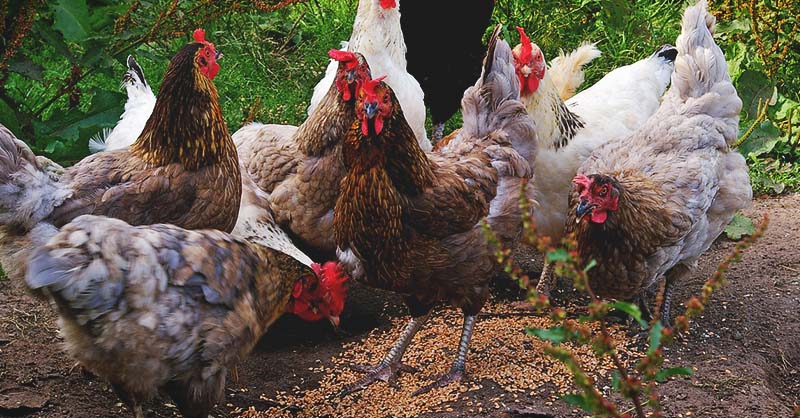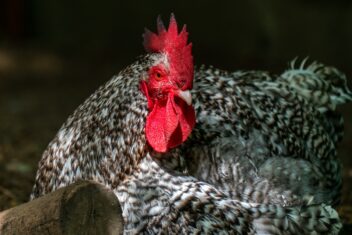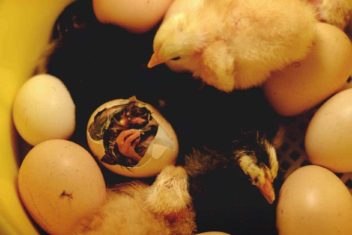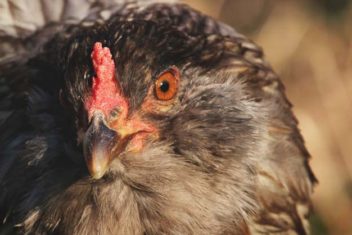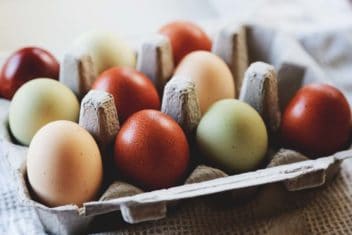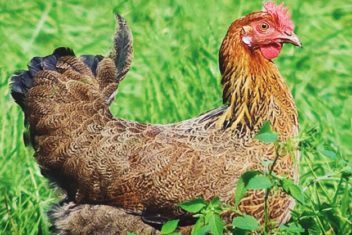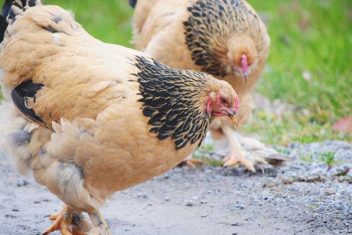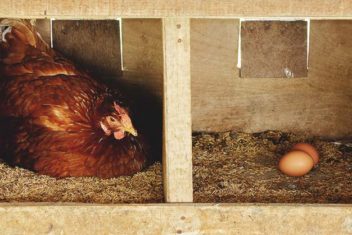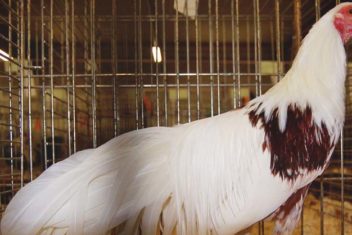People experienced in raising chickens always recommend having everything in place before the arrival of your birds.
By now you may have decided to raise chickens and have built your coop and run. However, have you purchased the most basic supplies, the feed, and the supplements for your chickens?
Perhaps a few minutes reading up on the following could ensure you are well prepared and knowledgeable in what your birds will need:
- Basic supplies you should buy;
- Feeding and watering techniques;
- Fulfilling their nutritional needs with cheap, homemade, healthy feed;
- Keeping them happy with different treats.
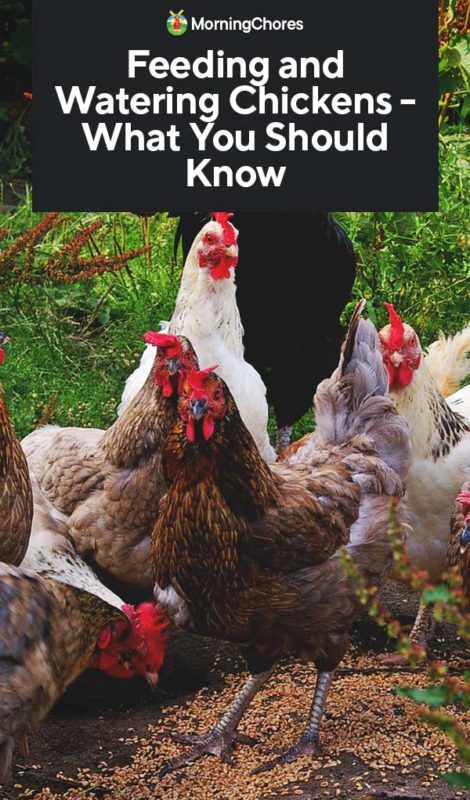
Prepping for Your Baby Chicks
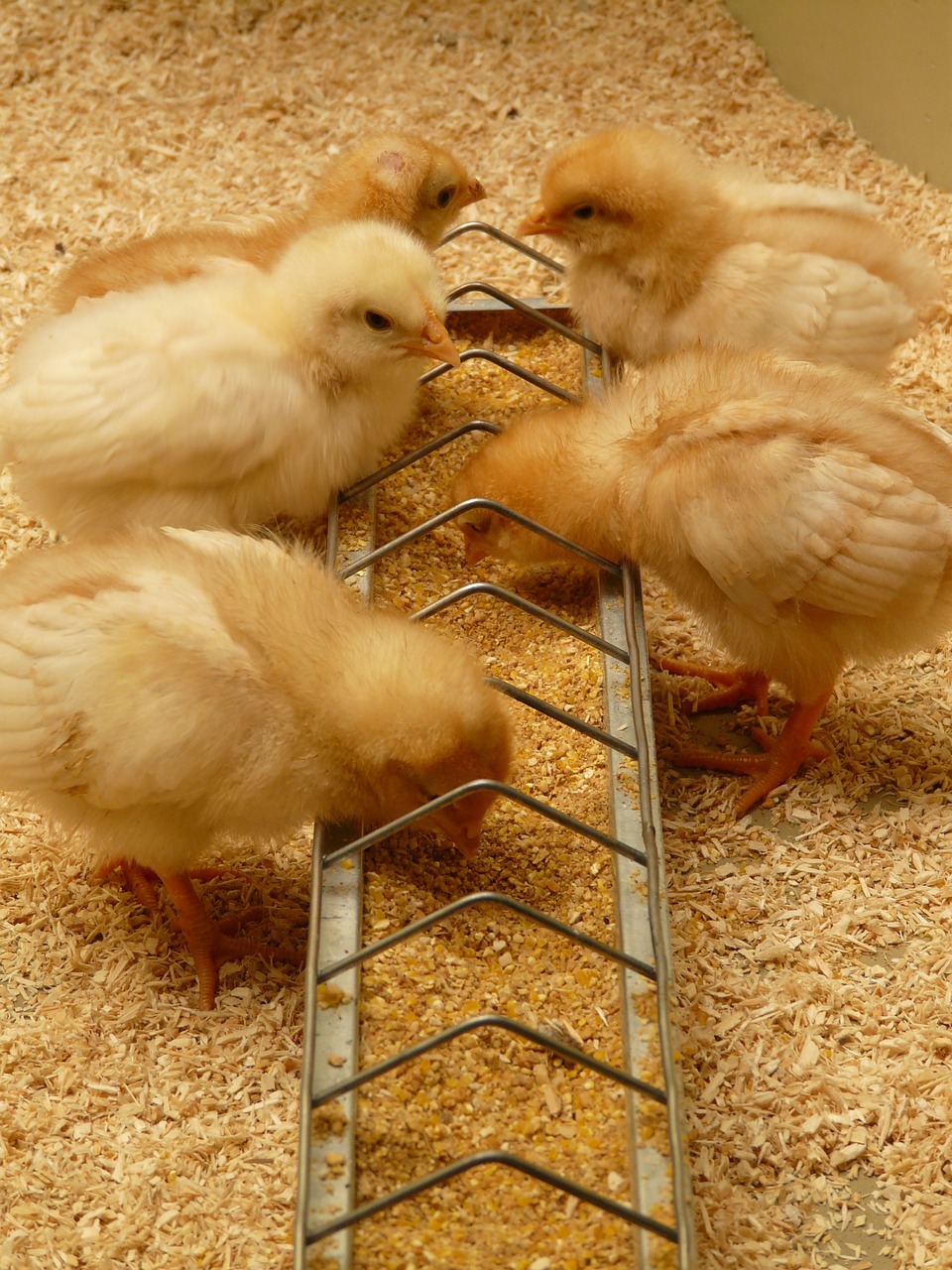
If you bring home grown-up chickens, they deserve to be treated nicely (just like any other pet). However, if you have decided to begin with baby chicks, there’s a lot to prepare beforehand. And yes, there’s a reason for that. Because they’re temperature-sensitive, baby chicks don’t adjust well to an environment that’s entirely new for them.
Besides this, the lack of initial care may result in common health issues among baby chicks such as dehydration, malnutrition, and infection. Some of them even die before reaching their destination. To avoid any such situation, you should get the following supplies before the baby chicks enter your home for the first time:
1. Brooder Box
The first 8 weeks of their life are crucial for your chicks’ overall health and wellbeing. Within this timeframe, a brooder box will be their first home.
There’s no need to buy anything, though. You can use a large cardboard box as the brooder box for your baby chicks. If you’re looking for more options, then go for an old washbasin. Once you have found one, you can place the baby chicks right there.
2. Bedding
Spread bedding/litter in the brooder box. Ideally, you should choose pine shavings because they are inexpensive. Also, the chicks do well in pine shavings, plus this form of bedding is easy to clean.
Never choose cedar shavings because they don’t only smell bad, they may cause respiratory problems in your chicks.
3. Thermometer
You’ll need this to know the exact temperature in the brooder box. For the best results, it’s recommended to keep the thermometer under the bulb or heat lamp.
4. Bulb or Heat Lamp
Baby chicks need an adequate source of heat until their feathers grow. You can buy one from any of the local chicken feed stores nearby your place of residence.
Once you have installed the source of heat in the brooder box and the chicks have arrived, get the brooder box warmed. Ideally, it should be 70-90°F. However, this may vary depending on the breed. Therefore, it’s always better to consult a vet before transferring the chicks to a well-heated brooder box.
5. Feeder and Waterer
While you’re at the local store, ask them about the feeder base, a plastic bottle, and a waterer for feeding and watering the baby chicks. There are varieties of feeders and waterers to choose from. You’ll know more about these in the following chapters.
In case you couldn’t get a waterer, an ashtray made of glass (or any heavy material) would be a temporary (but useful) alternative to a waterer. As you bring in the chicks, fill the waterer or ashtray with water, and keep checking if the water is clean.
6. Starter Feed
Local feed stores sell feed that’s specially formulated for baby chicks. It mainly comprises of mash or crumbs. Just ask them for the “starter feed,” and they’ll give you just that.
However, in case you forgot to buy a starter feed, but the chicks have just arrived, don’t leave them hungry. You can create a starter feed on your own for 1 or 2 days. Here’s what you need to do: put rice, barley, wheat, oats, or any other whole grains in a blender. Blend these grains slightly (make sure you don’t turn the grains into a powder. The feed should comprise of “grains” not powder).
Leave these grits in front of the chicks in the brooder box. They’ll eat whenever they need to.
Why Should You Feed Your Chickens Right?
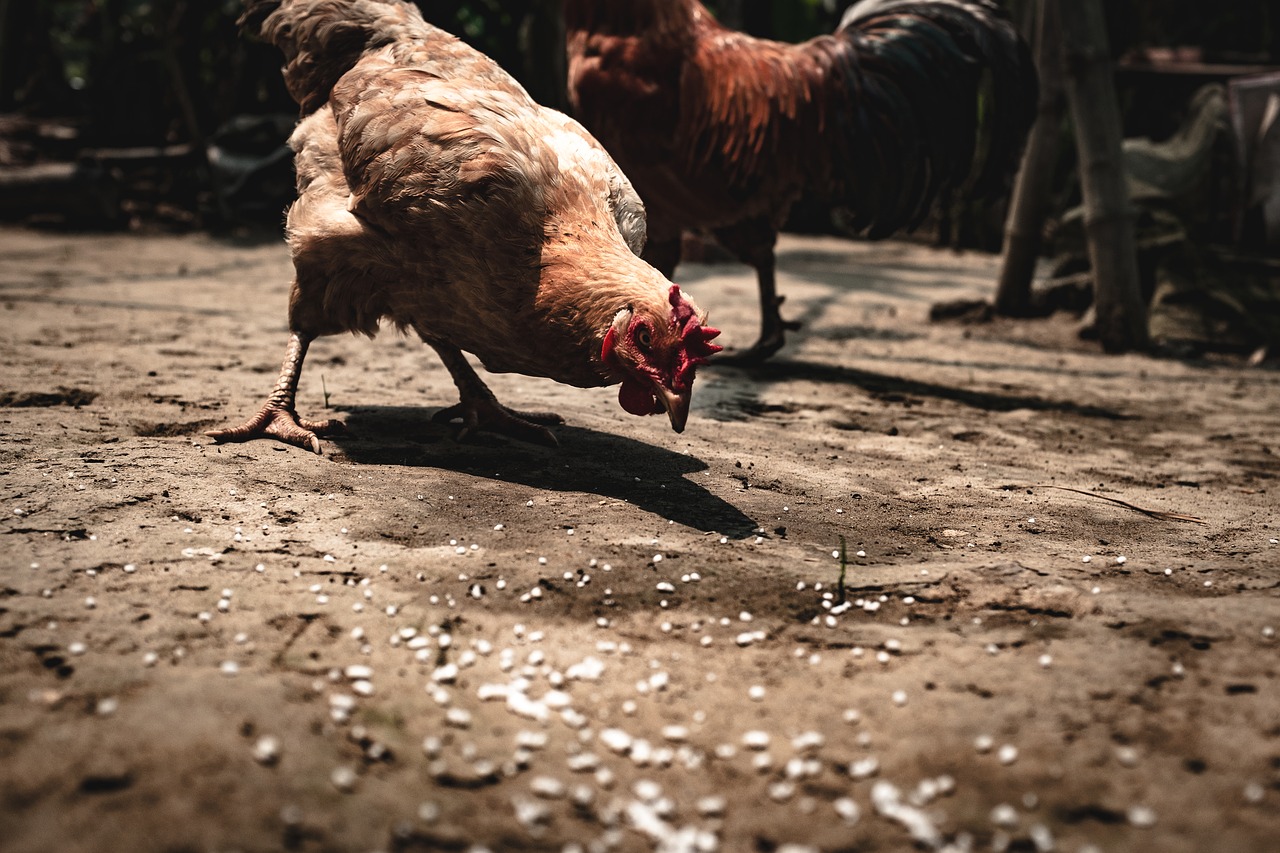
Because it’s all about providing your chickens the right nutrition.
Perhaps your grandparents are your mentors because they had been raising chickens even before you were born. They let their chickens run around their backyard. They fed them a few corns every other day. And their chickens grew just fine.
Still, here’s the reality: things are a lot different now.
We, as modern chicken keepers will have to keep in mind certain things that did work in the past but unfortunately, don’t make a lot of sense in this day and age.
Here’s why:
Previously, chicken raisers used to keep free-range chickens. Besides this, they also raised goats, sheep, or cows in their yards. When these animals spilled grains, the chickens could pick those grains up as their feed. However, now, this scenario is no longer applicable as modern chicken raisers don’t raise large animals with chickens.
Chickens are more confined to their housing. Even when you set them out, they cannot find a sufficient amount of feed that fulfills their daily requirement. Malnutrition may lead to the slow growth of broilers.
In the past, expecting a few eggs from backyard chickens was the norm. The chickens couldn’t produce a lot of eggs because of poor nutrition. However, now, the trend has changed.
Modern chicken raisers bring home their chickens and do everything they need to help the flock lay as many eggs as possible. That’s why you need to provide your chickens with the best, most nutritional feed instead of just a handful of corn.
You want your chickens to stay healthy and not die. Leaving them loose wouldn’t help them find food for themselves because the land doesn’t contain all nutrients your chickens should have access to. Secondly, you’d never want your lovely birds to be grabbed by a predator. Therefore, feeding them nutritious feed is the answer.
Some people advise leaving your backyard chickens on their own, so they can pick the best diet for themselves. However, this may worsen their eating habits. Consider your chickens as kids. They may not know the feed type that’s best for their health. They may pick their favorite feed and may fill up on this single diet only.
Which may lead to digestive issues. To avoid this situation, it’s better to provide them the feed that’s nutritious as well as filling for them.
Chicken Digestive System 101
Undeniably, nothing beats nutritional feed. However, there will be times when you’re feeding your chickens just the best diet. Even so, you suddenly observe that one of them is having a weird disorder.
What went wrong when everything was right?
It may be that one of your chickens is having problems digesting the food. So, before you can help the poor chicken recover from a digestive problem, it’s wise to understand their digestive system first. Once you know the basics of a chicken digestive system, it becomes easier to identify whether any of your chickens having digestive problems is normal or not.
Of course, chickens don’t have teeth. Their way of processing and digesting food is entirely different from mammals. It goes like this:
1. Crop
Resembling a pouch, a crop stores the food in the neck. As the chicken picks up the food in its beak, it’s transferred to the crop. Due to its stretchy nature, the crop expands as the chicken feeds.
In other words, a crop is a chicken’s food pipe. It’s the first part of its digestive system. Therefore, it’s essential to make sure that the crop is healthy enough to avoid any digestive problems.
2. Proventriculus
As the food travels down from the crop, it’s moved to the proventriculus. Basically, this can be considered the chicken’s stomach because the digestive enzymes can be found here.
3. Gizzard
Composed of strong muscles, a gizzard is an oval sac. When the food leaves the proventriculus, it goes to the gizzard. The grits picked and eaten by the chicken are stored here. As the muscles squeeze, the food particles are ground with the help of the grit. The role is similar to how our teeth break up the food we eat!
4. Intestines
After this, the food is moved to the chicken’s intestines while the intestine walls absorb the nutrients of the food.
5. Cloaca
The solid and the liquid waste are discharged through the cloaca.
Usually, it will take 2.5 hours for a chicken to digest food, from where it is eaten until it passes as waste.
Common Digestive Problems
Before diving into the possible digestive issues your chickens may get, it’s important to know when the chickens should have a “full” crop and when having an “empty” crop indicates a healthy digestive system.
Here are a few facts you should know about your chicken’s crop beforehand:
When the chicken has eaten feed during the daytime, food is stored in the crop. That’s why the crop may seem full when the chicken goes back to the coop at night.
If the crop is empty in the morning, it’s a sign of a healthy chicken. As the chicken eats during the day, the crop would be filled again and would be empty the next morning.
That is the cycle of a healthy crop. However, digestive problems may arise if your chicken’s crop doesn’t empty. In this case, your chicken may be experiencing the following issues:
1. Sour Crop
Sour Crop occurs when the chicken develops a yeast infection in its crop. This happens when the impacted feed remains in the crop and does not pass through the digestive system. Yeast grows in the food that’s still retained in the crop.
Your chicken has Sour Crop if the crop is large and squishy, an odor comes from its mouth, some smelly liquid comes out of the mouth, and the chicken is lethargic.
– Causes
- The crop doesn’t “fully” empty
- The chicken has swallowed pieces of rubber bands, plastic, or any other substances that are hard to digest
- The chicken had eaten long grasses, moldy feed, inadequate grits, or bread in excessive amounts
- The chicken has been fed with an antibiotic, but this caused a secondary infection
- The chicken has got a fungal infection
- The chicken has eaten worms. This has affected its digestion
– How to Treat It
Instead of trying to remove the sour crop on your own, it’s highly recommended NOT to take any risk as this could also lead to death! Therefore, begin with a natural diet. Feed your chicken with dried or fresh oregano (you can also add oregano oil to its waterer), plain yogurt, or fresh garlic.
If you don’t see any improvement, take your chicken to the vet immediately.
– How to Prevent It
If you notice that your chicken is having an impacted crop, treat it immediately.
It is very important to limit bread and similar carbohydrates in their feed.
Apple cider vinegar possesses anti-fungal properties. You can add one tablespoon of this natural medicine to 1-gallon of water. Do this weekly.
2. Impacted Crop
The food remains in the crop instead of moving to the chicken’s stomach.
Your chicken has developed an impacted crop if the crop has become firm and large (similar to the size of a tennis ball). The crop doesn’t empty. Besides this, the chicken drinks a lot of water but refuses to eat feed and is lethargic.
– Cause
Impacted crop occurs when a solid substance such as dried grass or straw is stuck in the crop in such a way that it tangles and blocks food.
– How to Treat It
- Avoid feeding the chicken until the impacted crop has been resolved. Your chicken cannot digest any extra food as its crop is filled with food already. The good thing is that chickens can survive for a few days without food
- However, do provide a lot of water. Even if it refuses to drink water, you can forcefully feed your chicken with water because that’s how you can clear the blockage
- You can also offer granite grit to the chicken
Again, if you see no improvements, it’s best to leave this to the vet.
– How to Prevent It
- If you allow your chickens to free-range, then limit their access to long grass or dead grass
- Take the chickens to the vet regularly. Frequent checkups will give you the peace of mind that your chickens are raised without developing an impacted crop
- Add granite grit in their feed
Types of Feed for Your Backyard Chickens
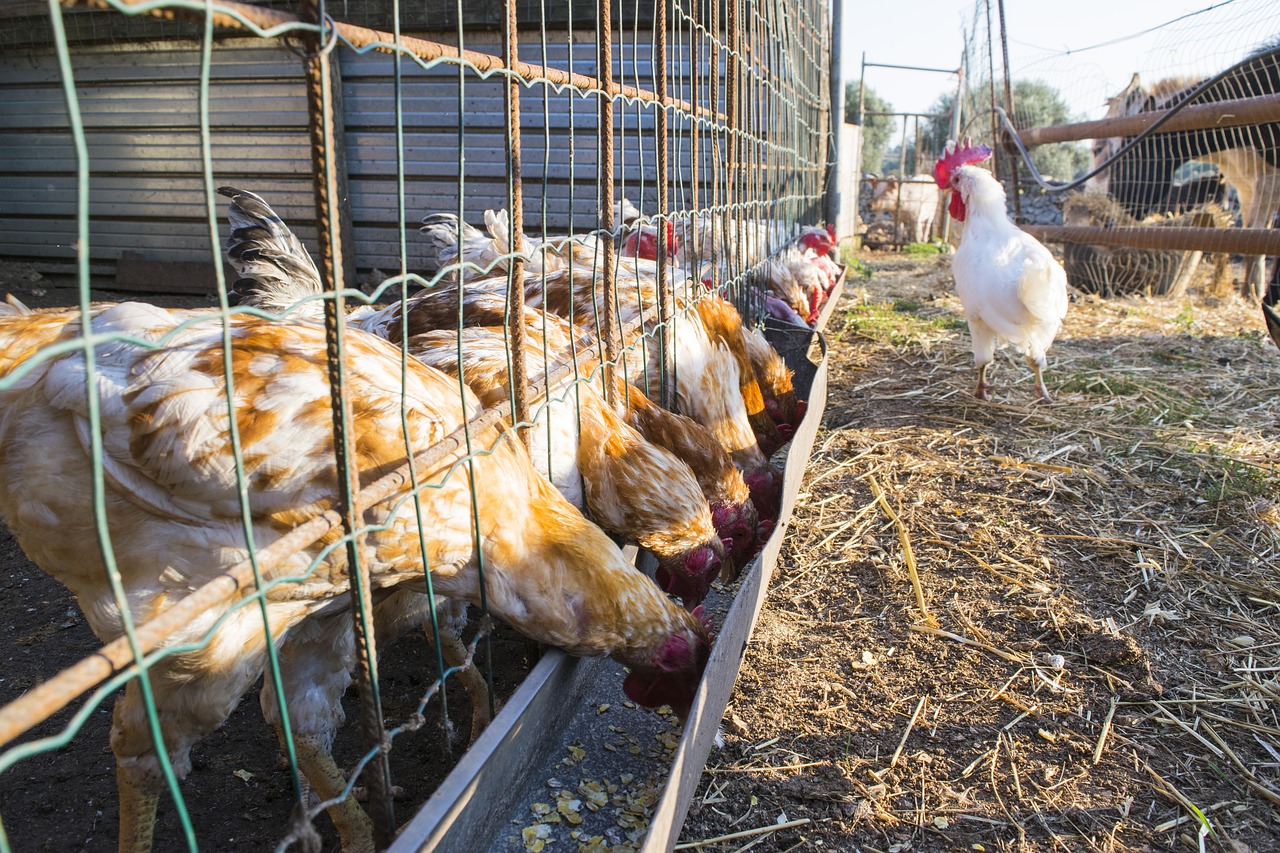
Before deciding the feed to give your chickens, it’s wise to know about each type in detail. Have a look at the description of each one along with the pros and cons:
1. Commercial Feed
Commercial feed has all the materials which are distributed for use in feed for animals.
Some of the items which are classified as commercial materials feed are:
- Animal Protein Products
- Plant protein products
- Fat and Oil Products
- Non-protein Nitrogen Supplements
- Processed Grain by-products
- Molasses Products
- Vitamin Supplements
- Mineral Supplements
One of the easiest ways in which you can feed a small flock of chickens is to get complete rations from the store. The crumbles, pellets, or mashes can fulfill the dietary requirements of your chickens.
Pros
- Commercial feed is convenient. Taking care of even a small flock of birds in itself is a hectic job. Buying commercial feed from the store makes maintenance of the chickens easier and less time-consuming
- It contains a balanced proportion of the nutrients needed by your chickens
Cons
- Commercial feeds are more expensive compared to the feed made at home. A homemade feed can reduce your costs if you know what goes in it
- Some of the commercial feeds may contain compounds that are hazardous to human health. Some feed may contain feces and plastics
- Some feed can also contain arsenic which is very detrimental to human health. It is used to make chicken meat pink. Arsenic-based additives are also used to kill parasites and promote growth. However, arsenic has been linked to cancers of lung, bladder, and kidney in humans
- A poor-quality feed can mean that the quality of meat will also be poor
- Commercial feed may come in the form of pellets. This is done so that the bird can eat more at the same time saving them from multiple trips to the feed. Chickens need to make multiple trips as they are nibblers by nature. However, many experts retain the belief that the meat is better when the bird gets more exercise
Tips
- If you are getting a ‘starter ration’ pack for your layer breed chickens, it must contain 20% protein. From the time they start eating, meat chickens require a high protein diet containing about 22- 24% protein. This needs to continue for the first 6 weeks
- Some brands may contain different ingredients in different parts of the country. Instead of just buying and throwing the grain to the chickens, spare a thought and go through the ingredients as well as protein and nutrient levels
- Don’t add anything extra such as calcium and minerals in the commercial feed. Excess of calcium can result in kidney failure. If you’re noticing thin eggshells or soft-shelled eggs, the best way to counter it is to put crushed oyster shells in a feeder, from which chickens can nibble according to their own need
- Commercial feed in the form of crumbles is the best. Keep the feed available for chickens so they can eat when the need arises
2. Medicated Feed
This type of feed contains a mixture of veterinary medicines. This requires a veterinary prescription before you can start giving it your chickens.
Sometimes, a medicated feed is the most effective way in which you can administer medicine to the livestock.
It’s formulated and given to chickens so that they can combat the disease namely coccidiosis.
Pros
- Many medicated feeds contain ‘Amprollium.’ This helps the chicks fight off cocci oocysts, while they’re in the process of developing their own immunity
- Antibiotics are used for the treatment of animal diseases or disease prevention. Administering medicines can ward off diseases and prevent them from dying
Cons
- If the birds have already been vaccinated against coccidiosis, the medicated feed will nullify the effect of the vaccination
- The main purpose of the Amprolium is to block thiamine uptake. Thiamine is needed in all living things in order to grow and remain healthy. In a few young chickens, it was observed that thiamine deficiency led to the “splay leg” condition
- Traces of medicine can find their way into the human food
- Extensive use of antibiotics has resulted in the growth of pathogens that are resistant to antibiotics
- According to a report by a joint panel of the National Research Council and the Institute of Medicine, many human diseases resistant to antibiotics have ‘clearly occurred’ because of bacteria from antibiotic-treated livestock
Tips
- You should stop giving them medicated feed at 18 weeks if you want layers and about 2 weeks before you plan to slaughter the chicken for meat. This should be done even if you haven’t completed the medicated feed course
- Also, medicated feed is not treatment if an outbreak of coccidiosis occurs. It can only be used as prevention
- It should also be remembered that medicated feed is not made for any diseases other than coccidiosis. You cannot use it to treat the chickens’ respiration problems
- Some of the times in which you can start giving medicated feed to your livestock is when you are breeding large batches of chicks like around 50+ at the same time
- If you’re rearing large batches consecutively, then also you might need medicated feed
- It is also of use if you’re living in a hot and humid environment
- If your facility has a noted history of coccidiosis, then also you might use medicated feed
Experts suggest that sunshine, good food, and a natural environment are the best medicines for chickens. If, however, you need to use medicated feed, check the labels and instructions on the feed before using them.
3. Homemade Feed
Poor quality of chicken feed can lead to slow growth of chickens as well as low egg quality. It can also lead to diseases or death.
Seeing this, many producers or livestock breeders have started to make their own homemade chicken feed. By doing this, they know what goes into their chicken feeds. The feed is organic as well as safe from any harmful elements.
The most common ingredients to make chicken feed at home include maize, maize germ, sunflower or fish meal (Omena), cottonseed cake, and soya beans.
Moreover, some farmers also add many food additives such as vitamins, minerals, and micronutrients to fulfill any dietary needs.
Pros
- It’s one of the best ways to ensure your chickens receive top-notch quality feed
- It’s pretty cheap compared to commercial feed. Due to government regulations, many commercial companies have reduced the standard but the price remains almost the same. This means that farmers making homemade feeds are raking in quite a bit of saving
- The chicken feed can be adjusted according to the needs of your livestock
Cons
- Preparing the chickens’ feed can be a complex procedure
- If you don’t have prior knowledge about chicken nutrition, it could work out to be more costly
- The feed has to be milled and mixed according to a set proportion, not randomly
- If the right amounts of nutrients are not included in the feed, chickens can suffer from nutritional diseases
Tips
- The material for preparing chicken feed can cost you less especially after the harvesting season. Depending on the cost of raw materials acquired, you can save up to 50% for every pound of chicken feed
- Lentils, barley, peanuts, wheat bran, and quinoa are some healthy items to be included in your chicken feed
- It should also be remembered that the percentage required for dietary nutrients varies according to each category of chickens. For instance, if you want to make a feed for layers, you have to include a minimum of 18% crude protein
- Though you can also add table scraps to the mixture, beware of adding fish meal and soy. Soy is a concern to some people because of its high concentration of phytoestrogen. Similarly, a fish meal has to be watched too as it can have a high level of mercury
- Don’t be tempted into creating a huge quantity of the feed at once and store it. Make smaller quantities at a time, and keep it fresh so that it can retain much of the nutrients
How to Cut the Cost of Feeding Chickens
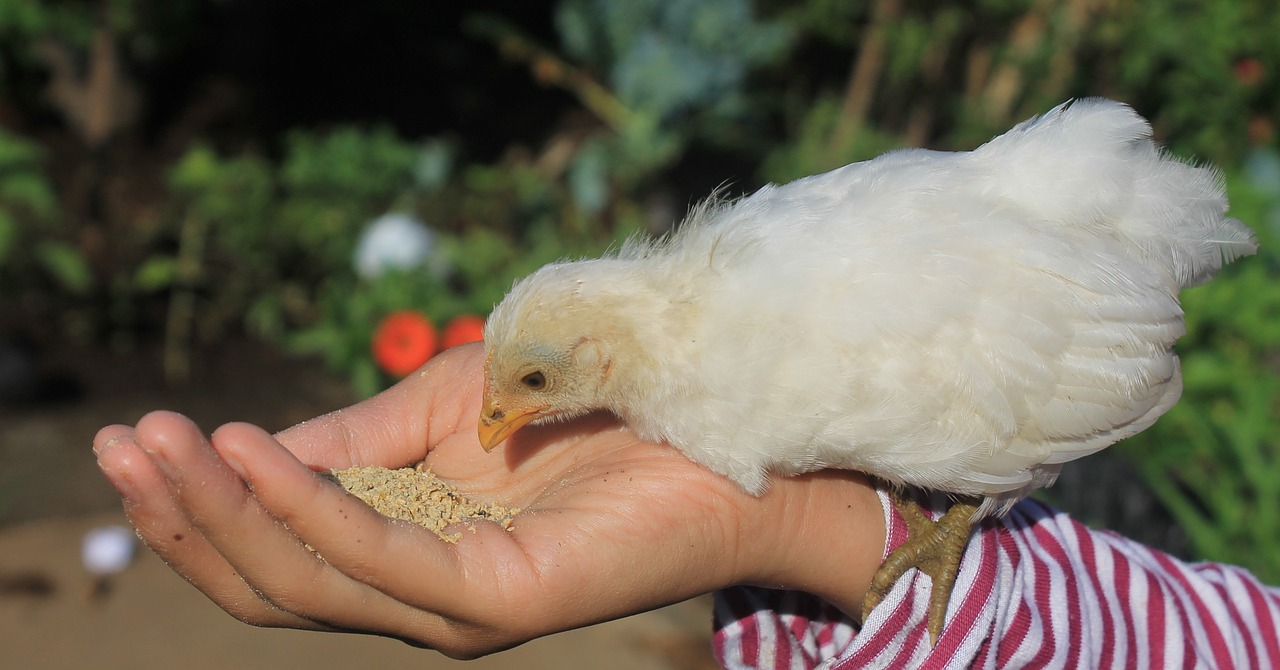
Is the feed store costing you a lot? Naturally, it can be heart-breaking to find out that the eggs you get from your backyard chickens are costing you more than the eggs you can buy from a local store! Though the cost of chicken feed is rising year after year, there is a solution for chicken keepers: you can still afford to provide the best, nutritional, and organic feed to your flock and that too within your budget.
Here’s how:
1. Grow Fodder
Soak and sprout seeds. Wait for a few days. And see the fodder grow! Though chicken keepers sprout a variety of seeds, you can start off with wheat.
Take a container and soak wheat seeds in it for 12-24 hours. After this, drill holes in a tub (for drainage), and place the seeds on it. Water these seeds daily. After 7 days, you’ll observe that the fodder has grown. The chicken feed is then ready for use.
Water Hyacinth is another cheap alternative to grow.
2. Provide a Free-Range Space or Pasture to the Chickens
If your chickens can safely roam around in a free-range setting (under your observation so that you can avoid any predator attacking them), then they can find their feed on their own.
Set them free during the day so they can eat some grass, bugs, weeds, seeds, sunflowers, and even tomatoes. Since this diet has a lot of variation, it will provide them with the nutrients of oyster shells.
However, if you have limited space or you just don’t feel comfortable leaving your chickens in a free-range space, then get a chicken tractor that helps them forage and gather their feed.
3. Table Scraps
Chickens eat almost all scraps except meat. Therefore, it’s a good option to feed them with this no-cost lunch! On the other hand, as the chickens will eat these scraps, you wouldn’t have to worry about any food going to waste. However, you need to work on portion control so the chickens don’t develop any weight problem.
4. Their Egg Shells
When you use their eggs, don’t throw their shells. You can use these eggshells to prepare a homemade chicken feed. That’s because feeding them their own eggshells helps them increase their calcium intake. Just grind their eggshells and add these to their feed. Again, this wouldn’t cost you anything at all.
5. Other Homemade Chicken Feed Options
For a more comprehensive list of chicken feed options, have a look at our post on cheap chicken feed and high protein chicken feed.
How to Prepare Chicken Feed at Home
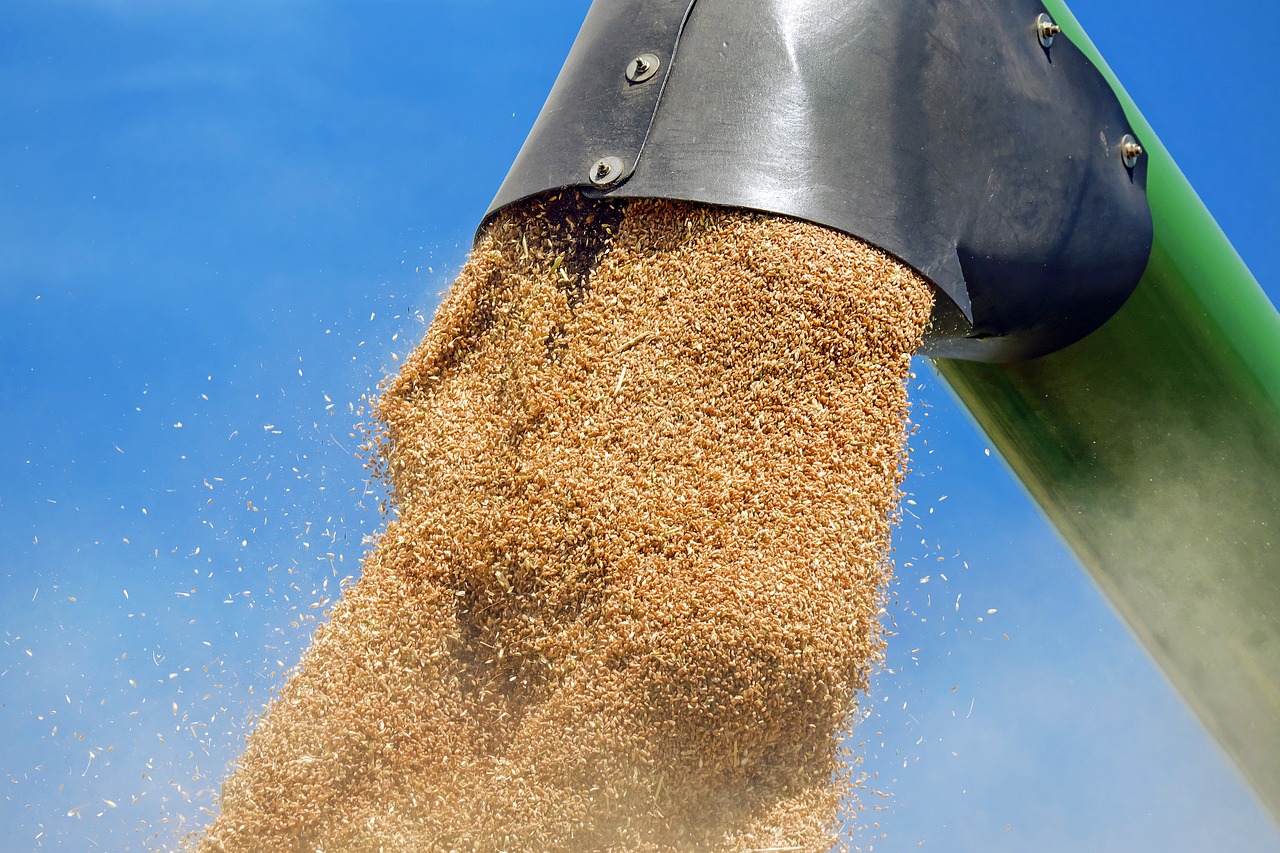
There’s a simple formula for this. If you have all the required ingredients, you just need to mix them up! And the homemade chicken feed is ready.
To begin your own chicken feed, have a look at the essential ingredients as well as their quantity:
- Wheat: 30%
- Oats: 10%
- Corn: 30%
- Peas: 20%
- Aragonite: according to choice
- Kelp: according to choice
Depending on the number of backyard chickens you have, you can buy the quantity of each ingredient accordingly.
Important Nutritional Supplements for Your Chickens
The feed given to chickens has to be full of nutrition so they can live a long, healthy life. If you’re breeding chickens commercially, this spells success for you too!
Supplementing the feed increases the chances of your flock fighting off any diseases. Here are some supplements you need to keep an eye out for and should include in the feed:
1. Grit
You would need to provide this since the chickens don’t have teeth to grind feed and hence this comes in handy.
2. Flower Petals
Free-range chickens will peck at anything edible so why not include something pleasing to the eye, such as colorful flowers, in their diet? Here’s a list of some edible flowers you can put in their feed:
- Echinacea Dandelions
- Dandelions
- Clover Blossoms
- Marigolds
- Sunflower seeds
- Roses
- Nasturtium
- Bee Balm
- Violets
- Squash blossoms
3. Food-Grade Diatomaceous Earth
Diatomaceous Earth is a combination of sodium, magnesium, and iron among other trace minerals, this one helps in improving the quality of eggs as well as stimulating metabolism. It also helps the bird in getting rid of internal parasites and helps heal any cuts and scratches sustained by the bird.
You can add half a cup of this mixture to every big bag of feed.
4. Probiotics
They aid in digestion, improving immunity and whetting up an appetite.
You can supplement feed with probiotics by including yogurt, sourdough bread, or kefir milk.
5. Dried Herbs
The birds might be reluctant at eating fresh herbs (probably due to the strong smell). They’ll eat it readily though when it is dried and crushed into their feed.
Ranging from being anti-toxic to being natural antibiotics, herbs can prove their worth at a number of instances.
Alfalfa, a super herb, comes complete with the package of amino acids, minerals, and proteins.
If you need a laying supplement, then you can use fennel seeds while chickweed is a great food for chickens.
Some of the herbs you can use are sage, spearmint, parsley, nettles, alfalfa, and chickweed.
6. Calcium
This will be needed by the laying hens for the production of eggs. You can supplement it by putting eggshells or crushed oyster in the feed.
7. Garlic and Apple Cider Vinegar
Adding apple cider vinegar can prevent diseases and boost immunity in your chickens. It can also discourage parasites from invading the flock.
Add 1 tablespoon per gallon of water once a week. Add it only to plastic waterers.
Rest assured as adding the vinegar will only make the water more palatable to your pets!
Another thing to use is garlic. This also boosts the immune system of chickens and can discourage external parasites such as mites and lice. Crush a clove of garlic and drop it in the water or you could sprinkle garlic powder in the feed daily.
Tasty Treats for Chickens
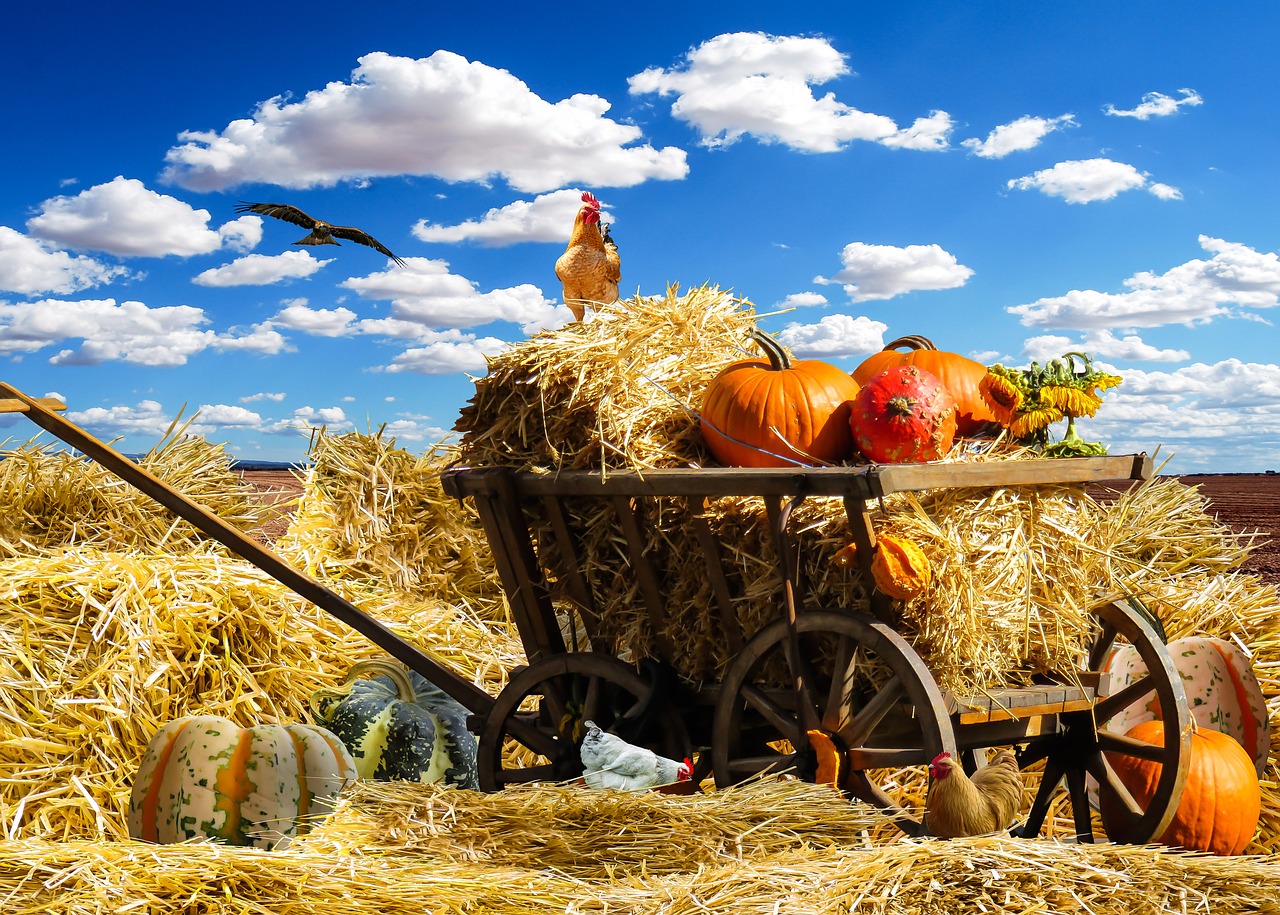
All feed and no treat makes chicken life a dull one! Just like us humans, chickens need some occasional treats too.
The treats are not just to keep the chickens happy, they also help in keeping them healthy and safe. Also, they can be substituted for plants in winter when the plants are buried in snow.
However, once you give them the treats, remember to provide them with grit in a separate feeder so they can easily digest whatever they have eaten.
1. Fruits
They’re a human favorite and one that your chickens would love too. Packed with vitamins and low in fat, they make for an amazing treat.
You can let your chickens run wild in an orchard or plant a few fruit trees near the coop so the chickens can peck at the fallen fruit.
2. Cabbage, Broccoli, and Cauliflower
Broccoli is seldom loved by kids and if you bought quite a lot accidentally, give some to your chickens. This super veg group is healthy with cabbage having the most amount of calcium in the above 3 (6.3%).
You can mix it up with grated carrot and cucumber slices and a healthy green garden salad is ready for your beloved pets.
3. Berries
Chickens love berries so you can plant a few berry bushes in the area. They contain vitamins A, B complex, and C as well as beta-carotene.
4. Pumpkins
Packed to the brim with protein, this tasty treat can be given whole to your chickens. You can carve a large hole at the side and let the chickens peck their way through the rest of the pumpkin.
5. Melon and Watermelon
You give them to the chicken for the same reason you would eat them – to stay hydrated!
Leave a watermelon bowl and let the chicken feed themselves.
6. Oatmeal
This one can be a favorite treat in the wintry months. You can throw in some garlic and fresh herbs to enhance its benefits. A great source of vitamins and nutrients, they truly are a treat.
Foods to Avoid at All Costs
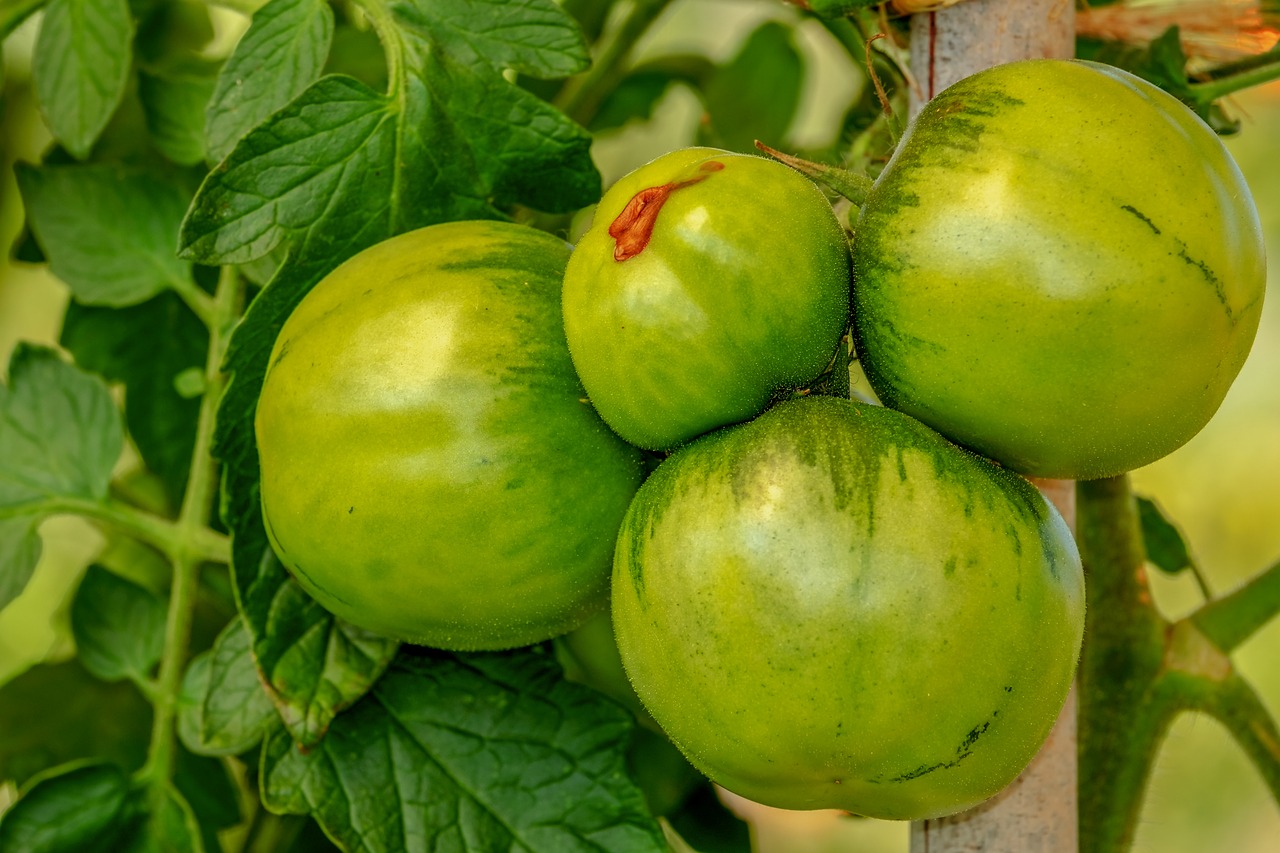
Your chickens will eat almost anything. However, not everything is good for them. In fact, some foods can potentially kill your backyard chickens.
Here’re some of the deadly foods to avoid:
1. Moldy Food
Some mold can be good but we cannot discern among the good and bad mold growing on soft fruits. Therefore, it’s best to avoid it.
2. Green Potatoes and Green Tomatoes
They contain toxins namely solanine and chaconine, making it poisonous for your chicken. They’re not altered by cooking.
3. Dried/Raw Beans
They can result in serious illness and even death in chickens. Kidney beans are the worst offenders.
They contain a fatal toxin phytohaemagglutinin.
4. Salty Foods
Too much salt can lead to the condition of salt poisoning in chickens. Chickens can tolerate up to 0.25% salt in drinking water.
5. Chocolate
Chocolate can cause heart problems in your pets and even lead to a heart attack so it’s best to reserve the chocolate cake just for yourself.
6. Parts of Avocado
A toxin carried by the avocado, ‘persin’ can cause heart problems in chickens.
What You Need to Know About Chicken Feeders
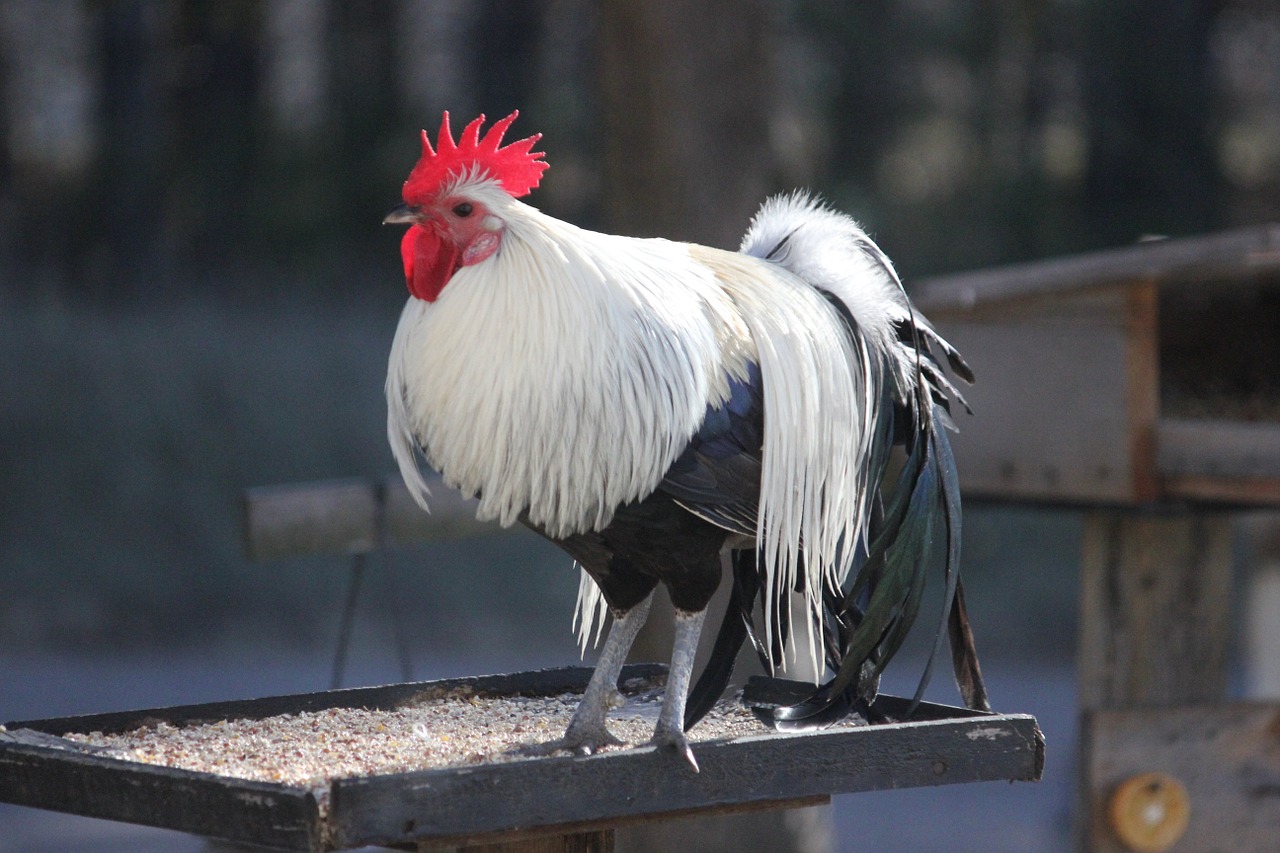
A poultry feeder is a piece of equipment containing feed for your livestock. The chickens can come to it and take the feed from it as and when they feel the need to eat.
Poultry feeders are available in many shapes and sizes. Some can be round and tubular while some will lie horizontally on the ground and can be made of plastic or metal.
Here are a few types of poultry feeders you can use for your chickens:
1. Trough
These can be affixed to the side of the coop or also function on their own. Some troughs also have their own roof.
The advantages are that they allow several chickens to feed in a row at the same time. Refilling them is easy as they’re open. The high sides of the trough reduce the chances of chickens scratching out feed with their feet or beak.
The trough should be large enough to stand on its own. Otherwise, you should secure it to something so that it doesn’t fall over.
2. Open Container Bin
They’re similar in purpose as the trough but not long in shape like the trough.
This type of poultry feeder is easy to refill. However, it can get overcrowded if several birds are trying to eat from it at the same time.
3. Tread-Plate Feeders
They have been around for many years, and are again gaining popularity. They can be quite expensive. This type of feeder can hold up to 10-20 kg of dry feed.
Thread-plate feeders work by making use of a pressure plate system in which the chicken steps onto a plate. A lid subsequently opens allowing chickens to eat. When the bird steps off, the lid shuts protecting the feed from birds and wild animals.
Since rats can’t get inside the feeder, this type of feeder is a great option if the feeder is out in the open environment.
4. PVC Tube Feeders
The tubular and round ones work best when you fill them with pelleted or crumbled feed. This type of feed can easily flow steadily as the birds eat. However, the problem arises when you fill these feeders with mash feed.
Many chicken producers use mash feed as it has the same nutritional value but is cheaper to use. However, you would find that using mesh leads it to clump together and not flow out in a steady stream. The result will be that chickens will not be well-fed, leading to slow growth rate, fighting amongst chickens, and reduced egg production.
The PVC tube feeders can easily be replicated at home and are lightweight, simple, and can be attached to any wall or post.
With these feeders, the drawback is that only one chicken can feed at a time and hence a seasoned chicken breeder would suggest you install a poultry feeder for every 4 birds.
These feeders can also be placed as a secondary source of poultry feed so that birds bullied at the main feed area, can also get feed.
How to Buy the Right Chicken Feeder
It’s important to buy the right type of chicken feeder as this can spell out the difference between the success and failure of your chicken keeping. You have to make sure that all your chickens have access to the right amount of feed for them to be in great condition.
If you have too few feeders and some birds are aggressive, the others might be left out.
Also, the wrong size of the feeder can make it difficult for the chickens to get fed from the feeder. Incorrect design of a feeder can also lead to spillage and wastage of food, thus increasing your costs.
To get the best out of a poultry feeder, make sure you check all these items on your list:
1. The Number and Size of the Birds
If the number of your backyard chickens is increasing, and you’re bringing home new breeds of different sizes, you would need to install a bigger poultry feeder. If you have a few birds, then you can do well with a smaller sized poultry feeder.
2. Physical Dimensions
Can the poultry feeder work with the given setup? It is pointless getting a poultry feeder that cannot even fit in through the coop door!
3. Easy Access of Feed for All Chickens
This means that each and every chicken should be well-fed. If you have a large flock but only one feeder, chances are that the chickens with the slowest pecking speed might remain hungry.
Also, if you have a mixed flock consisting of both large fowls and bantams, it would fare well if you get multiple feeders to cater to the different sizes of your chickens.
Smaller sized chickens can get their feed from low-hanging feeders while larger chickens can get fed from relatively higher feeders.
4. Frequency of Refilling
You would need to see the average amount of the chicken’s daily feed intake so you can accordingly buy a feeder that can contain this amount of feed conveniently. An adult chicken of medium size will consume about 4 oz (¼ lb) of feed in a day. This feed quantity can vary by the type of feed and size of the bird.
If you have a flock of 20 chickens and you choose to have only a 5lbs feeder, then you will need to refill it every day. However, if the number of chickens increases, you would have to buy another one to accommodate the larger number of chickens.
5. Spillage
While some spillage is unavoidable, no matter what feeder you use, it can be reduced to a certain extent. So, if you get a feeder with high sides, chances are less feed will be spilled on the ground.
There are many feeders sporting a restrictive barrier on top of the feed. This prevents the chickens from scraping out the feed.
6. The Environment
If you live in an area where wildlife is rampant, you may need to employ certain strategies and get a type of feeder preventing other animals from eating the feed meant for your chickens.
Watering Your Chickens
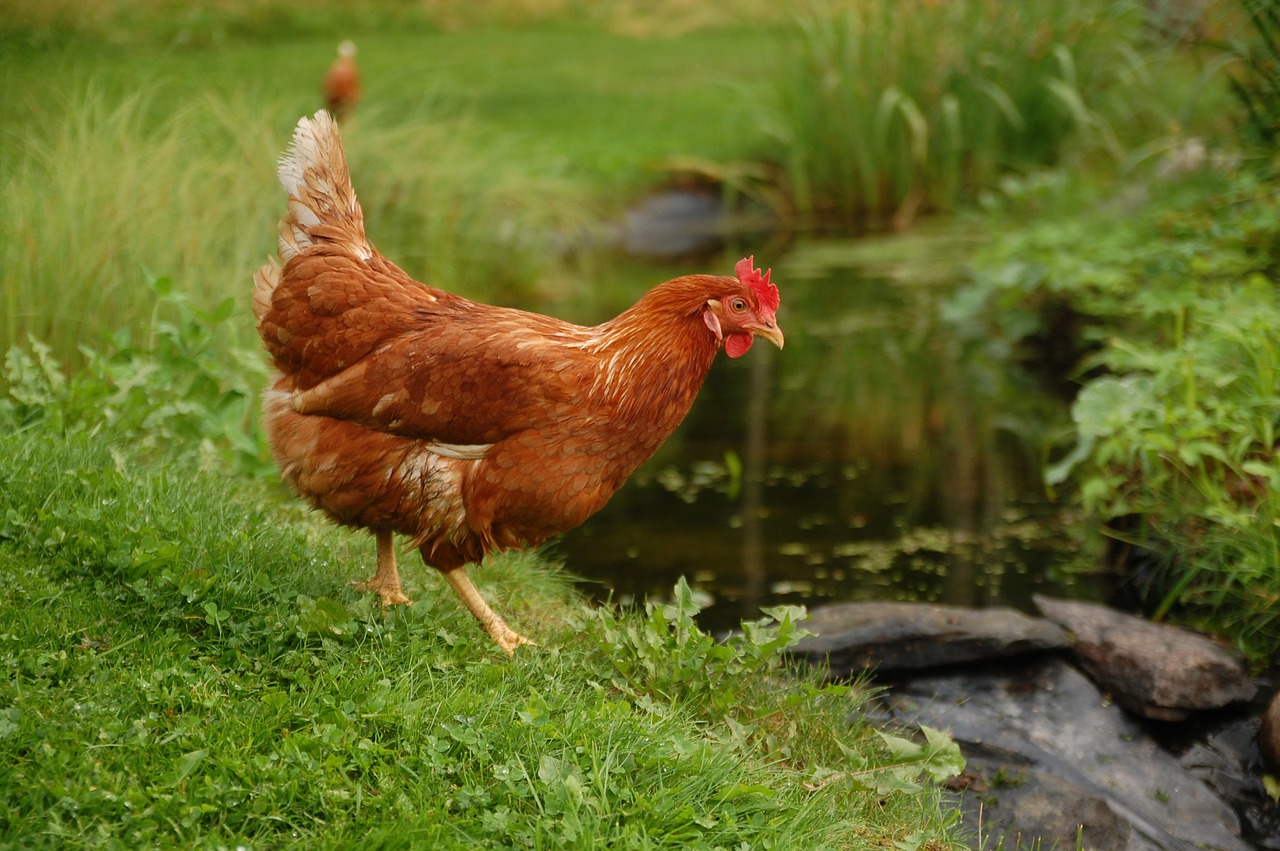
When observing them, it does not seem that chickens drink much water. Even so, in a day, each adult chicken consumes about half a liter of water in moderate weather. In summers, the quantity can jump to around a liter.
If you are breeding meat birds, they’ll visit the waterer more frequently as they’ll be growing at a faster rate.
If you’re breeding free-range chickens, it depends on how busy they’ve been out exploring for their feed and how much water is there in the plants and grass consumed by them.
You need to refill your chicken waterer considering the amount consumed by the chickens. Overestimate the amount consumed and choose the waterer accordingly.
Besides this, it’s essential to keep the water free from any manure and debris so the chickens are drinking clean water.
For good quality water, do the following:
1. Elevate your water
This will help you quite a lot in keeping all debris out of the water.
Keep waterer away from the roosting and nesting places. Otherwise, you would wake up to nothing else than fresh chicken poop all over the water jug! Chickens poop a lot while laying eggs and at night.
2. Keep replacing the water
This will help in making sure the water is clean and free of any algae. Otherwise, if the water keeps sitting there, it would start smelling bad. This is certainly not the kind of water you’d want to give to your chickens.
How to Train Your Chickens
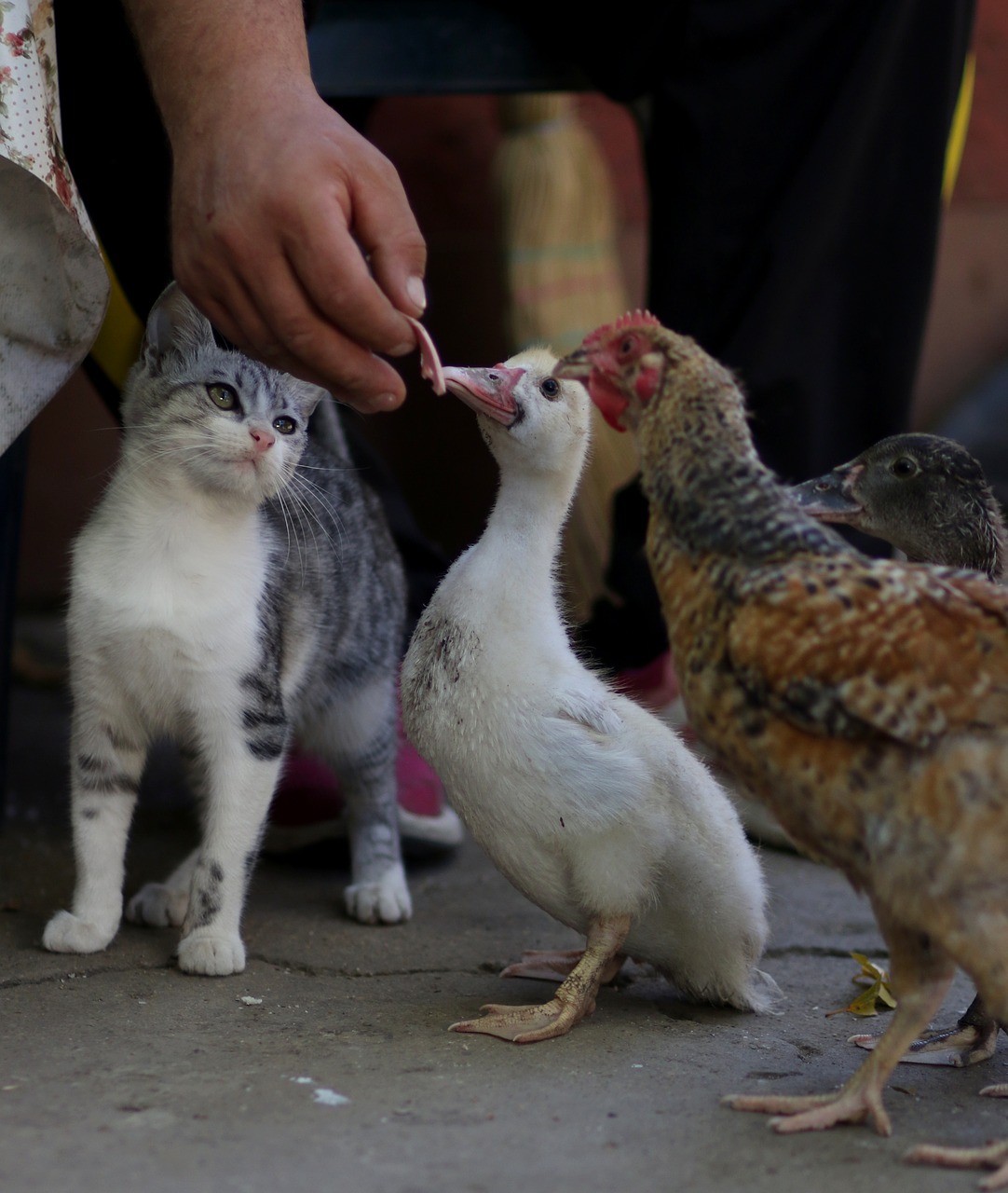
There’s no hard-and-fast rule to train them. However, the better thing to do is certainly to train them to respond to you. Training the chickens comes in handy in the following situations:
- Teaching them to feed and drink by themselves
- Ushering them into a certain area
- Making them return to the coop
- Ushering them away from an area of danger
- Having them respond and behave to your call as and when necessary
In addition, by training them, you can give them a set timetable or routine according to which the chickens will proceed through the day. This can be done by opening and closing the coop at the same time collecting eggs, cleaning their manure, and giving them their feed at the same time each day.
Here’s how to train them:
It’s easier to train a small flock of birds. The more chickens there are in a flock, the harder it can be to train them as you wish.
To train them, you can follow these steps:
- Stand at some distance from your chicken(s). Hold the food behind your back. Click a pet clicker or make a signal. Within a second, give the food
- For 3 days, do it 2 times a day
- The next step would be to again hold food behind your back. Make a signal through a pet clicker when the chicken is looking away from you and offer it food immediately
- By this time, the chicken will start associating the signal with food
- The last step would be to stand away from your chicken and make a signal and offer it food at the same time
Now, the chicken should run right over, indicating that it’s trained!
Conclusion to Feeding and Watering Chickens
As you can see, there’s a lot to more to feeding and watering chickens than one would expect. If your initial aim was to save money, you can easily overspend by buying the wrong food, the wrong feeder, or just not feeding them correctly which could lead to illness and death.
Rather be prepared, make sure you have everything in place even before you bring your chicks home, and especially plan to create your own homemade chicken feed. It is healthier, and wholesome knowing you are providing the optimal nutrients so that you too, at the end of the day, can benefit from wholesome eggs and meat.
